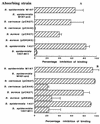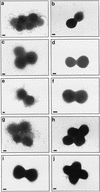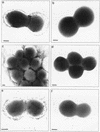The ica locus of Staphylococcus epidermidis encodes production of the capsular polysaccharide/adhesin
- PMID: 9746568
- PMCID: PMC108579
- DOI: 10.1128/IAI.66.10.4711-4720.1998
The ica locus of Staphylococcus epidermidis encodes production of the capsular polysaccharide/adhesin
Abstract
Clinical isolates of coagulase-negative staphylococci often elaborate a biofilm involved in adherence to medical devices and resistance to host defenses. The biofilm contains the capsular polysaccharide/adhesin (PS/A), which mediates cell adherence to biomaterials, and another antigen, termed polysaccharide intercellular adhesin (PIA), which is thought to mediate bacterial accumulation into cellular aggregates. PIA is a polymer of beta-1, 6-linked N-acetyl glucosamine residues with a molecular mass of <30, 000 kDa. We found that recombinant Staphylococcus carnosus and Staphylococcus aureus carrying a plasmid with genes of the ica locus, which was reported to encode the biosynthetic proteins for production of PIA, were also able to synthesize PS/A. PS/A and a chemically and immunologically identical polysaccharide isolated from S. carnosus carrying the ica genes on plasmid pCN27 were found to be high-molecular-mass (>250,000 kDa), acid-stable polymers of beta-1,6-linked glucosamine substituted on the amino group primarily with succinate, although some preparations also contained acetate. Moreover, all recombinant staphylococcal strains with the ica genes had the biologic properties previously attributed to PS/A. ica-positive strains readily formed an in vitro biofilm on plastic, adhered 3- to 10-fold more to catheters during a 30-min assay compared with control strains carrying only the cloning vector, adsorbed out antibodies to PS/A from immune serum, and elaborated a capsule visualized by immunoelectron microscopy with antisera to PS/A. These properties were also seen with PS/A-producing strains of Staphylococcus epidermidis, but not with transposon mutants lacking PS/A. An antiserum raised to PIA contained high-titer antibody to PS/A that was readily adsorbed out by PS/A-positive strains of S. epidermidis and recombinant strains of staphylococci carrying the ica genes. We conclude that the ica locus encodes production of PS/A and that the properties of S. epidermidis associated with initial bacterial adherence, biofilm formation, and intercellular adhesion can be correlated with elaboration of PS/A.
Figures





References
-
- Augustin J, Gotz F. Transformation of Staphylococcus epidermidis and other Staphylococcal species with plasmid DNA by electroporation. FEMS Microbiol Lett. 1990;66:203–207. - PubMed
-
- Benerjee, S. S., T. G. Emori, D. H. Culver, R. P. Gaynes, W. R. Jarvis, T. Horan, J. R. Edwards, J. Tolson, T. Henderson, and W. J. Martone. 1991. Secular trends in nosocomial primary bloodstream infections in the United States, 1980–1989. Am. J. Med. 91(Suppl. 3B):86S–89S. - PubMed
Publication types
MeSH terms
Substances
Grants and funding
LinkOut - more resources
Full Text Sources
Other Literature Sources
Molecular Biology Databases
Research Materials
Miscellaneous

